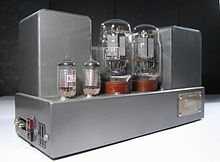Quad electroacoustics
| Quad electroacoustics | |
|---|---|
| legal form | private limited company |
| founding | September 14, 1936 |
| Seat | Huntingdon , Cambridgeshire , UK |
| Branch | Manufacturing and distribution of consumer electronics |
| Website | www.quad-hifi.co.uk |
Quad Electroacoustics is a UK company that makes hi-fi products .
history
The company was founded in 1936 by Peter J. Walker (1916–2003) in London as SP Fidelity Sound Systems and renamed Acoustical Manufacturing Co. Ltd in the same year. Five years later the company headquarters were relocated to Huntingdon .
With the amplifiers QA12 / and QA12 / P, the first products for end users were offered in 1948. The QUAD I, a tube mono amplifier (15 watts), was produced from 1950 to 1953. Its successor, the QUAD II, was built from 1953 to 1970. In 1957, the ESL, later the ESL-57, was the world's first electrostatic loudspeaker . It was also built under license by the German company BRAUN as the LE1 with a more modern outer shell . Two years later the QC 22, a stereo preamplifier with a separate AM / FM tuner, came onto the market.
In 1966 the first transistor amplifier for the professional market was offered: 50 and 50 / E. One year later, the Quad 33 stereo component system was brought onto the market, and by 1985 over 100,000 had been built. From 1975 to 1982 the quad power amplifier 405 and the power amplifier 405-2 that replaced it were built. In the late 1970s, precursors 34 and 44 were introduced. In 1981 a new electrostatic loudspeaker was brought onto the market with the ESL-63.
In 1982 the company was finally renamed QUAD Electroacoustics Ltd. renamed.
In 1995 QUAD Electroacoustics Ltd. sold to Verity Group plc, which also owns the Wharfedale and Mission brands. Production was completely relocated to Shenzhen in China.
In September 1997, QUAD became part of the International Audio Group together with Wharfedale. Since Walker's death, QUAD has no longer had any connection to the originally founded company with its former quality standards.
Hi-fi products
Peter Walker's intention was to bring high quality hi-fi products into the living room. The electrostats from Quad, which Braun manufactured under license , have become famous .
Quad II
After the Second World War , Peter Walker designed a pre-amplifier / power amplifier combination with associated radio receivers. A later version with 40 watts uses the tube type KT88 instead of KT66.
Quad 33
This preamplifier was built by quad electroaccoustics in Huntington between 1967 and 1985. It originally belonged to a set consisting of the preamp itself, the output stage 303 and the VHF radio receiver FM3, as well as a wooden housing in which the preamp and receiver were to be placed. There is also said to have been a long wave receiver. The devices are narrower than the 19-inch standard that is common in hi-fi systems. In terms of sound, the system is based more on the previous Quad II models with tube technology.
Inputs and outputs: The Quad 33 has DIN inputs. Only the later models of the 34 and 44 series had cinch inputs. On the back there are inputs and outputs for the tape, a phono input and a radio input. So you have a total of 4 entrances. With the exception of the phono, the inputs are initially designed for a signal strength of 100 mV. However, since today's devices emit high levels of 1000 mV, attenuation of −20 dB should be built in here (this can be done in the cable via a resistor). The inputs offer enough reserves to cope with high-level signals without distortion. The tape deck is controlled via the tape card, on which volume adjustments can be made. The phono card enables both magnetic and moving coil systems and must be re-plugged accordingly. The output for the power amplifier is also located on the rear. This is a 4-pin DIN connector.
Control options: The volume potentiometer is also the on and off switch. This was also the case with other systems of that time (e.g. Klein + Hummel, but here the altitude potentiometer). However, the potentiometer is of poor quality and has poor synchronization in the lower volume range. The tone control is structured as follows: First of all, there are the treble and bass controls . Then there is also a potentiometer for controlling certain frequencies that have been preselected using buttons (quasi-parametric tone control).
Quad FM3
Together with the Quad 33, the FM 3 FM tuner was developed in the same design.
Quad 303
Transistor output stage with 2 × 45 watts at 8 ohms. The Quad 303 was designed together with the Quad 33 as a successor to the tube system. The tonal properties were so convincing that Pink Floyd used the 303 as a monitor power amplifier in the studio.
Quad 34
In the late 1970s, the two preliminary stages 34 and 44 were sold and replaced the model 33. Still based on the color of the Quad 33, the early models of the Quad 34 still had DIN connections. The later models then had cinch inputs and outputs. The principle of installing plug-in cards for phono inputs (magnetic or moving coil) has been supplemented by a circuit board for CD. The separation into a preliminary stage with a final stage was also retained. The Quad 34 was combined with a Quad 405 power amplifier. But the 34/44 can also be combined with a Quad 303.
Quad 44
The Quad 44 preamplifier is the bigger brother of the Quad 34 and is therefore the successor to the Quad 33. New features included cinch inputs and outputs, a CD input and a new sound control.
Quad 405
The Quad 405 amplifier is a semiconductor output stage with low distortion. The core element is the new current dumping principle, for which the company has received a patent (US Patent 3,970,953, expired).




